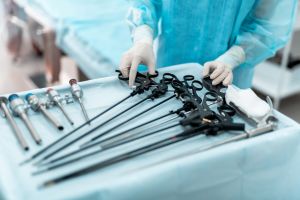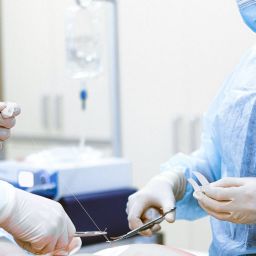Laparoscopic Surgery, known as diagnostic laparoscopy, is a surgical procedure used to scan the abdomen’s body part. It is mini-invasive and a low-risk technique that needs only small cuts.
A laparoscope is an instrument used in laparoscopy to examine the abdominal organs. A laparoscope is an elongated, slender tube with an extreme intensity light and a super-resolution camera at the front. The instrument is incorporated through a scratch in the abdominal walls. As it moves along, the camera transmits images to a video display monitor.
However laparoscopy is a great invention as it allows your doctor to take a look at organs inside your body in real-time, without open surgery. Although It is also possible to take biopsy samples during the laparoscopic procedure.
When was laparoscopic surgery first used?
In 1901, the first laparoscopic procedure was performed in dogs. Hans Christian Jacobaeus of Sweden was the first who performed laparoscopic surgery in humans. In the subsequent several decades, laparoscopy was further refined and popularized.
Why is laparoscopic surgery used?
Laparoscopy is used to detect and diagnose the cause of pelvic or abdominal pain. Undoubtedly When noninvasive methods could not diagnose the root cause of pain, laparoscopic surgery tools can help.
In various cases, abdominal issues can also be analyzed with imaging techniques such as:
Ultrasound: In this technique, high-frequency sound waves are utilized to create images of the body parts being examined.
CT scan: In this technique, a series of special X-rays are used to take cross-sectional images of the body.
MRI scan: in this technique, magnetic and radio waves produce images of the body parts.
When any of these tests could not give adequate information or insights for a diagnosis.This procedure helps take a biopsy, or tissue sample, from a particular organ in the abdomen.
Laparoscopy usually helps to examine the following organs:
- Appendix
- Liver
- Stomach
- Spleen
- Pelvic or reproductive organs
- Pancreas
- Gallbladder
- Small intestine and large intestine
Examining these organs with the help of laparoscopic surgery tools, the surgeon can detect the followings:
- An abdominal mass or tumor
- Liver disease
- The degree to which particular cancer has reached
- Fluid in the abdominal cavity
- The effectiveness of certain treatments
Laparoscopy helps in the early treatment of any disorder due to a timely diagnosis.
Benefits of laparoscopic surgery
Laparoscopic surgery has several advantages over general surgery. The main benefits are:
- Minimal invasive
- Less pain
- Reduced risk of infections
- Lower blood loss
- Smaller scars
- Short hospital stay
- Fast recovery
Laparoscopic surgery training courses
Different laparoscopic training courses are available to train doctors. The main objectives of these courses are:
- To improve the care quality received by patients
- Establishment of minimum standards for fundamental cognitive and technical skills used in laparoscopic procedures
- To provide surgeons practicing laparoscopy with standardized educational information based on laparoscopic surgery and a tool to help in the development of judgment and manual skills
Laparoscopic surgery videos are also available on various platforms. These videos can help the trainers a lot to clearly understand the procedure.
Laparoscopic trainers
The laparoscopic trainer is a commonly available device for the training of skills required in laparoscopic surgery. The trainer is composed of its
- camera
- display units with the LED monitor
No more additional equipment is required to use this instrument.
The movable camera makes it possible to change the visual angle of the operating space. Trainer‘s one side covering dome is transparent, a metallic foil covers the other side. This arrangement permits training in two modes.
Firstly the basic mode enables absolute beginners to control the training of laparoscopic surgery tools underneath direct eye control.
Secondly the advanced mode enables the control of an operation space through a display on a screen. This mode gives a perfect simulation of a real laparoscopic operation to more advanced surgeons.
The top of the trainer consists of sixteen ports which enable the instrument to introduce in various directions.
The laparoscopic trainer is supplied with a basic suturing set :
- Maryland forceps (2pcs)
- specimen mounting tray
- skillset (4 tasks)
- Metzenbaum scissors
- performance assessment software (PASS)
This is the overall score for your text and snippet preview.
Laparoscopic surgery trainer box and practice kits are available of various qualities. Innovative and affordable laparoscopic surgical instruments are also available at https://www.gerati.com/. It is the best source of high-quality laparoscopic surgery training kit, practice kit, laparoscopic instruments, e.g., laparoscopic scissors, dissector, needle holder, etc.
Laparoscopy surgery simulator
In laparoscopic procedures, this type of virtual reality most commonly used in surgeons’ training. it is not possible to see the operation being performed. The simulator utilizes a computer screen representing three-dimensional graphics of the organs under surgery.
Society of laparoscopic surgeons (SLS)
Although SLS is an instructive but non-profit organization established to ensure the highest standards for the practice of
- Firstly: laparoscopic
- Secondly: Endoscopic
- Thirdly: Mini-invasive techniques.
A large number of laparoscopic surgeons are members of this society. The purpose of this society is to design high-quality laparoscopic surgery tools.
What are the risks of laparoscopy?
The most commonly experienced risks associated with laparoscopy are infection, bleeding organ damage in the abdomen. However, these are infrequent occurrences. It is essentially important to visit your doctor if you experience any of these symptoms:
- Fever or chills
- Continuous nausea or vomiting
- Inability to urinate
- Persistent cough
- Lightheadedness
- Abdominal pain that becomes intense over time
- Redness, bleeding, swelling and drainage at the incision site
- Shortness of breath
During laparoscopy examination there is a minimal risk of injury to the organs.
Leakage of blood or any other fluid may occur in your body if any organ is punctured. In this situation, another surgery will be done to repair the injury.
How to prepare for laparoscopy?
It is necessary to tell your doctor about any medication you are already taking.
The dose of some medication may affect the results of laparoscopy. These drugs include:
- Nonsteroidal anti-inflammatory drugs (NSAIDs), including ibuprofen or aspirin
- Herbal or dietary supplements
- Anticoagulant such as blood thinners
- Medications that affect blood clotting
- Vitamin K
If you are pregnant, you must tell your doctor. It is necessary to decrease the risk of any harm to your developing baby.
Often, doctors order some tests (blood tests, chest X-ray, urinalysis, and electrocardiogram) before laparoscopy. Furthermore these tests will help your doctor to analyze the inside of your abdomen visually.
Moreover this can enhance the effectiveness of laparoscopy. It is necessary to stop eating and drinking at least eight hours before laparoscopy.
What is the procedure of laparoscopic surgery?
Laparoscopy is generally ,performed as an outpatient procedure. You will be capable to go home the same day you have surgery. The surgery possibly done in an outpatient surgical center or a hospital.
Most commonly, general anaesthesia is given for this surgery. It means that you will sleep through the procedure and will not feel any pain. An intravenous (IV) line is incorporated into your veins.
Sometimes, it is preferred to use local anaesthesia instead. The local anaesthesia is used to numbs part whose surgery is to be done. So although you will be awake during the whole procedure, you will not experience any pain.
During the laparoscopic procedure, the surgeon makes a small cut below your belly button. After that a small tub which is known as cannula is inserted. The cannula inflates the abdomen with carbon dioxide gas. This gas makes the abdominal organs visible.
Once the abdomen is inflated, the laparoscope is incorporated through the small cut. Particularly a camera is finely attached to the laparoscope that displays the image on a screen. The purpose of camera is to make the abdomen organ visible in real-time.
Moreover the size and number of cuts depend on the type of disease. To whom Which this surgery is being performed. Generally ,one to four cuts are made and each between 1 and 2 centimeters in length. The purpose of these incisions is to make entry of other instruments.
After the procedure is complete, the tools are removed. The cuts are then covered with stitches or surgical tape. Bandages can also be used over the cuts.
Gynecologic laparoscopy
Undoubtedly Gynecologic laparoscopic is a better alternative to open surgery. The laparoscope is used to examine the pelvic area of the female. In the case of open surgery, a large incision is required. Endometriosis and fibroids are easily diagnosed by laparoscopy. Laparoscopy is also used as a treatment. It is used to perform a variety of gynaecological surgeries. These include:
Ovarian cyst removal
Tubal ligation
Hysterectomy
Laparoscopic surgeries generally have a shorter healing time than general surgery as small incisions have to be made in them. Its mostly preferred over general surgery.
Is laparoscopy an expensive treatment?
Laparoscopic cholecystectomy , generally used for the treatment of gallbladder diseases. it is cheaper than open surgery. Laparoscopic sigmoidectomy and appendectomy surgery are safer method of mini-invasive surgery, slightly more expensive than general open surgery.
Results of laparoscopy
Normal results from laparoscopy show the absence of abdominal firstly bleedings, secondly intestinal blockages, and thirdly hernias. It means that all your organs are healthy.
However abnormal results show certain conditions, including:
- Appendicitis
- Cysts
- Cancer
- Fibroids
- Pelvic inflammatory disease
- Hernias
- Cholecystitis
- Endometriosis
The doctor will schedule an appointment with you to consider the results. Consequently he will discuss appropriate treatment options with you to control any abnormality.



